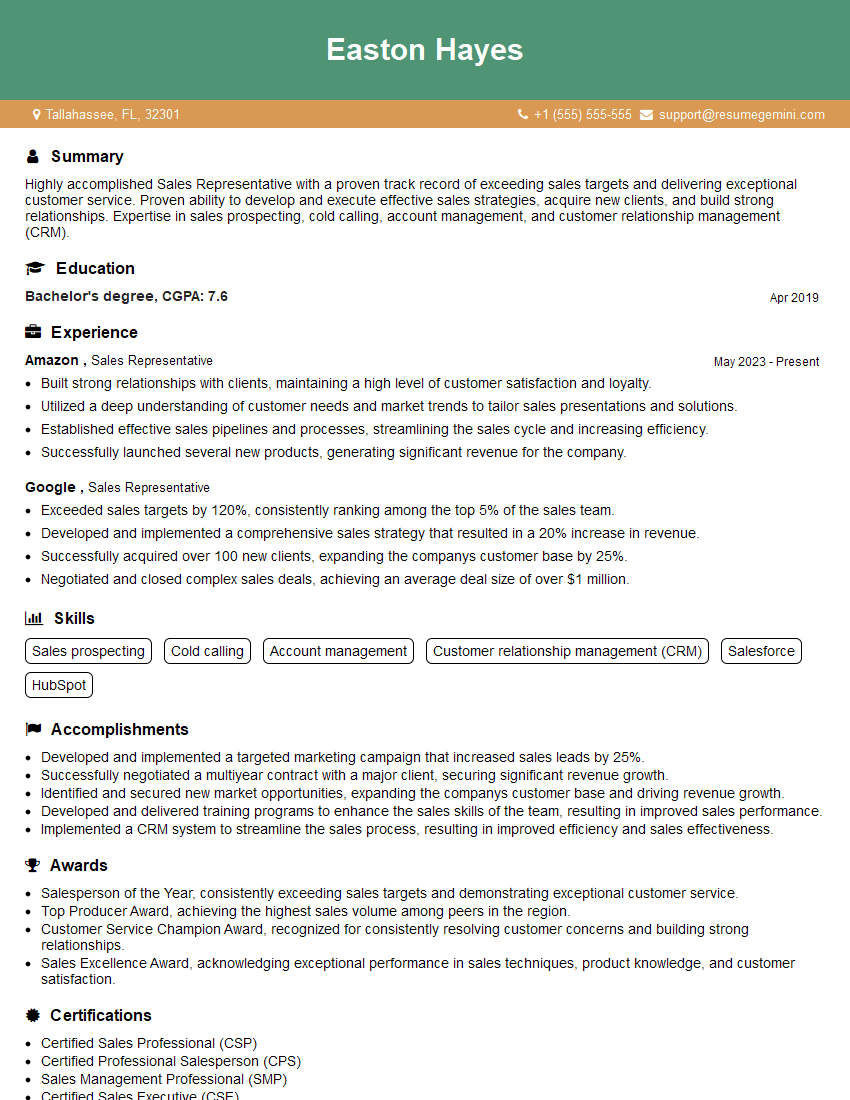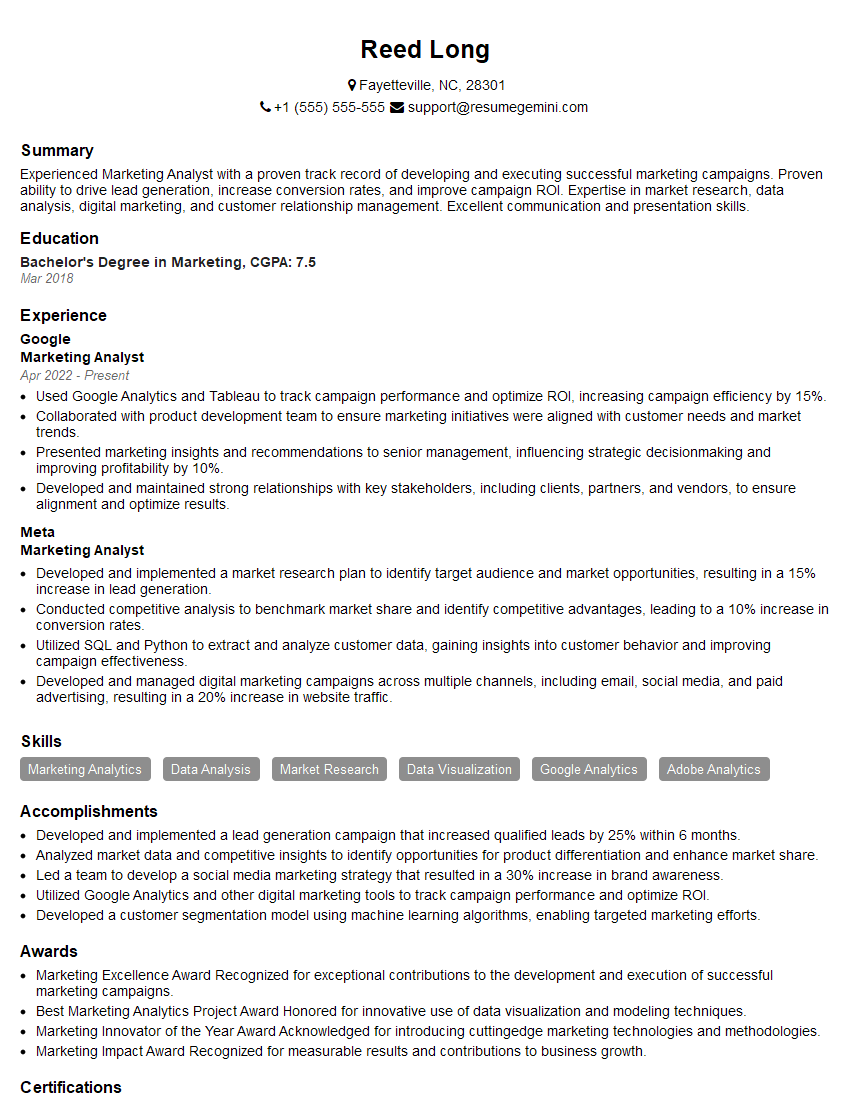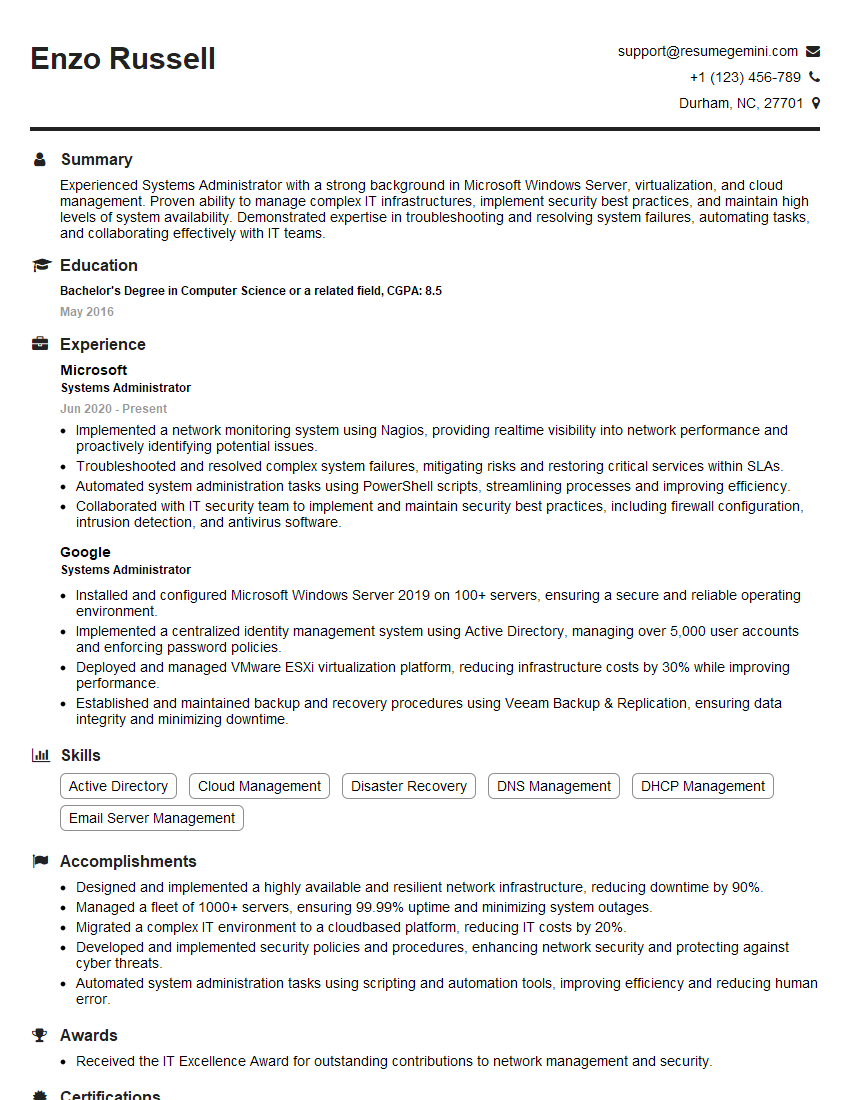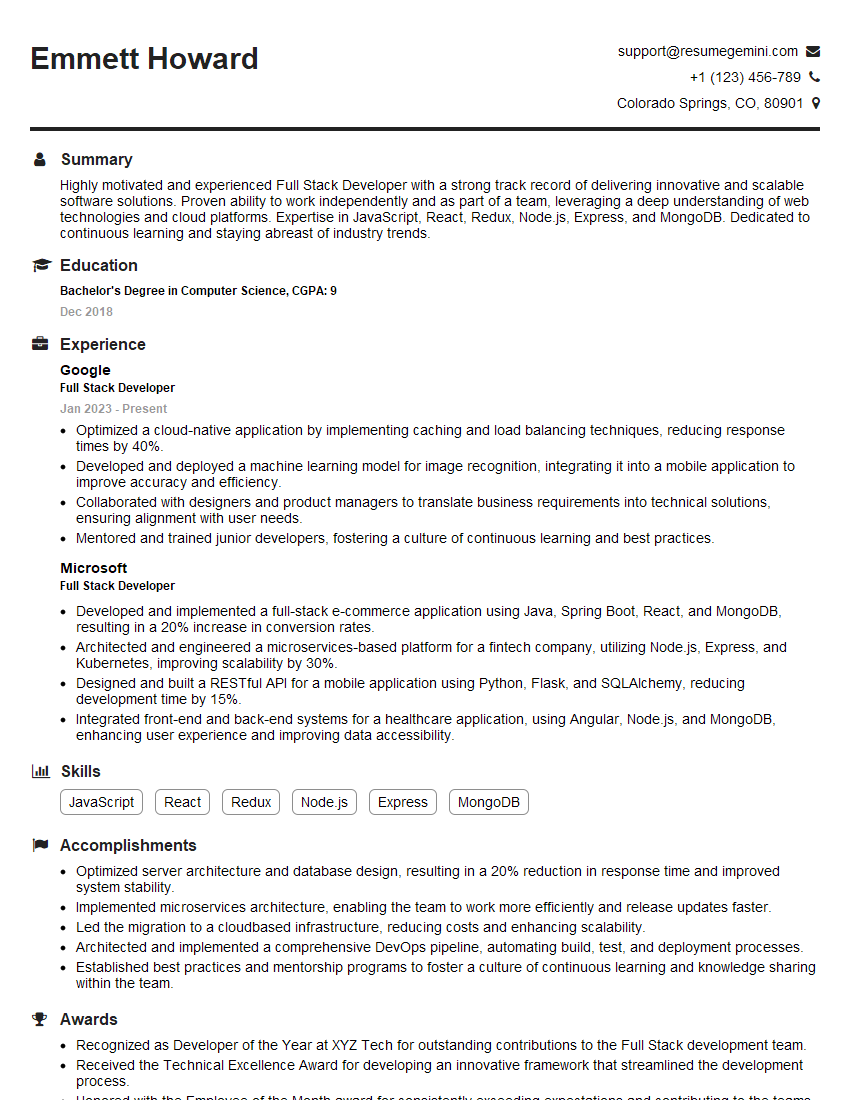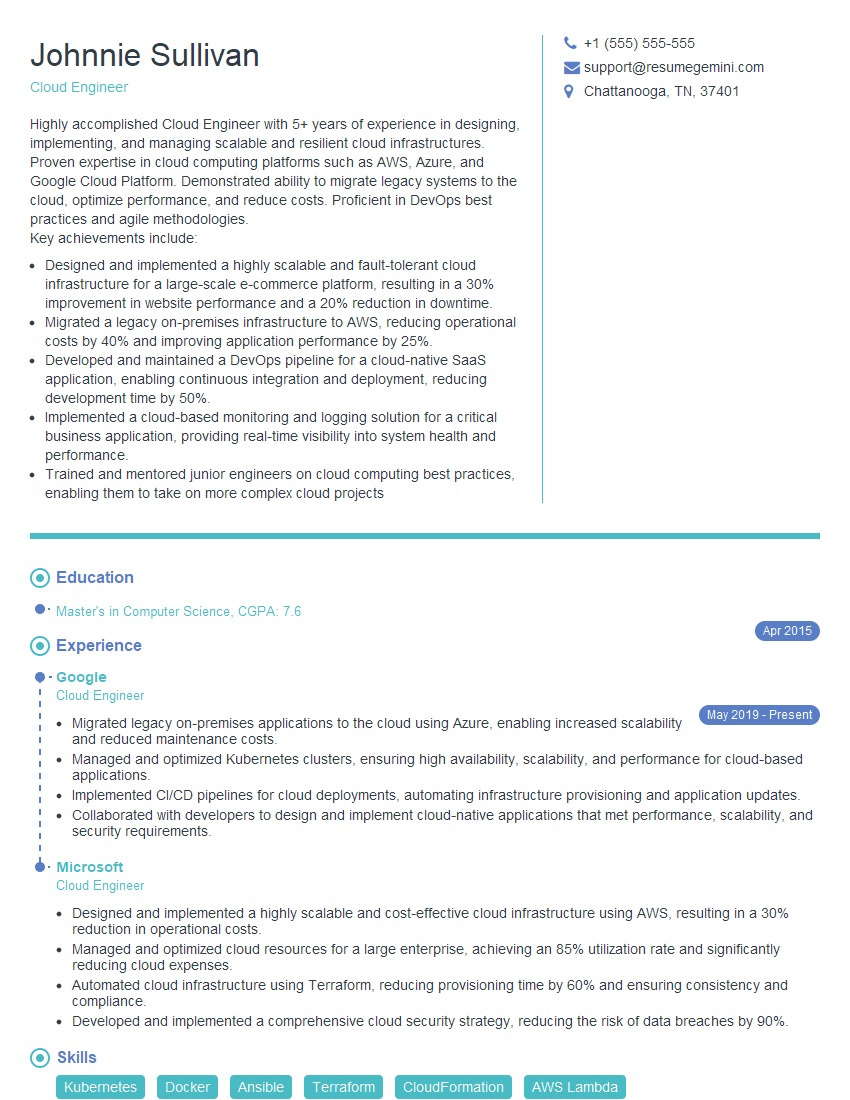Are you ready to stand out in your next interview? Understanding and preparing for Ability to Learn Quickly interview questions is a game-changer. In this blog, we’ve compiled key questions and expert advice to help you showcase your skills with confidence and precision. Let’s get started on your journey to acing the interview.
Questions Asked in Ability to Learn Quickly Interview
Q 1. Describe a time you had to learn a new skill quickly. What was your approach?
Learning a new skill quickly involves a strategic approach combining focused effort, efficient resource utilization, and consistent self-assessment. For example, when our team transitioned to a new project management software, Asana, I needed to become proficient quickly to contribute effectively. My approach was threefold: First, I dedicated specific blocks of time each day solely to learning Asana, minimizing distractions. Second, I leveraged Asana’s own tutorials, online documentation, and even watched YouTube videos demonstrating practical applications. Finally, I immediately started using Asana on small tasks, gradually increasing complexity to reinforce my learning through practical experience. This hands-on approach, combined with targeted learning resources, allowed me to become productive within a week.
Q 2. How do you prioritize learning new information when facing multiple deadlines?
Prioritizing learning amidst multiple deadlines requires a structured approach. I employ a system combining urgency and importance. I use a matrix to categorize tasks, plotting them based on their urgency (immediate vs. later) and importance (high impact vs. low impact). Learning tasks are treated like any other project with deadlines. For instance, if a crucial project requires mastering a new coding language, I allocate specific time blocks daily or weekly, treating it like a mini-project with its own deadlines, ensuring its completion doesn’t compromise other urgent tasks. Breaking down the learning into manageable chunks, combined with effective time management, keeps me on track.
Q 3. What strategies do you use to quickly grasp complex concepts?
Grasping complex concepts demands more than simply reading or listening; it requires active engagement. My strategies include breaking down the concept into smaller, digestible parts. I use analogies and real-world examples to connect abstract ideas to something familiar. For instance, understanding complex network protocols became easier when I visualized them as a postal system with various stages (addressing, routing, delivery). Visual aids like diagrams and mind maps are crucial. Furthermore, I actively test my understanding by teaching the concept to someone else or by creating summaries and explanations in my own words. This process of active recall strengthens understanding and identifies knowledge gaps.
Q 4. How do you handle unfamiliar technologies or software?
Encountering unfamiliar technologies or software is an opportunity for growth. My approach involves a systematic investigation. I start with the software’s documentation, paying particular attention to tutorials and quick-start guides. Next, I search for online communities or forums where users share tips and troubleshooting advice. I often find introductory videos on platforms like YouTube extremely helpful. Finally, I experiment directly with the software, focusing on core functionalities first and gradually exploring more advanced features. Hands-on experience is key. For example, when I first encountered Python, I started with basic syntax examples and slowly moved to more advanced concepts, consistently checking online resources and practicing code snippets.
Q 5. Describe your experience with online learning platforms or resources.
I have extensive experience with online learning platforms such as Coursera, edX, Udemy, and LinkedIn Learning. These platforms offer structured courses, often with interactive exercises and assessments, providing a valuable complement to traditional learning methods. I find the flexibility of online learning especially beneficial, as I can adjust the pace of my learning to fit my schedule and focus on specific areas of interest. I appreciate the ability to access a diverse range of courses and materials from leading experts and institutions globally. The ability to review material at my own pace and interact with instructors and fellow students is invaluable.
Q 6. What resources do you typically use to learn new skills?
My typical resources for skill acquisition are varied and depend on the skill itself. I frequently use online courses and tutorials (as mentioned above). I also rely heavily on official documentation, books, and articles from reputable sources. Participating in online communities and forums provides valuable insights and allows me to interact with experts in the field. I also find that mentorship and collaborative learning are extremely beneficial for accelerating the learning process.
Q 7. How do you assess your own learning progress?
Assessing my learning progress is an ongoing process. I use a combination of methods: self-testing using quizzes and practice exercises, creating summaries and explanations of the material in my own words, seeking feedback from colleagues or mentors, and applying my new knowledge to real-world projects. Regularly reviewing my notes and identifying knowledge gaps are crucial. Tracking my progress using a simple spreadsheet or project management tool helps to maintain focus and celebrate milestones, reinforcing motivation and providing a clear picture of my achievements.
Q 8. What is your preferred learning style (visual, auditory, kinesthetic)?
While I don’t rigidly adhere to a single learning style, I find myself most effective using a multimodal approach, leveraging the strengths of visual, auditory, and kinesthetic learning. Visual aids like diagrams, charts, and presentations significantly enhance my comprehension. I also benefit greatly from auditory learning, such as listening to podcasts or lectures, allowing me to process information passively while multitasking. Finally, I find hands-on experience and practical application (kinesthetic learning) crucial for solidifying my understanding and developing proficiency. For example, when learning a new programming language, I find that reading documentation (visual), listening to tutorials (auditory), and writing code myself (kinesthetic) provides the most comprehensive and lasting learning experience.
Q 9. How do you stay motivated to learn new things, even when it’s challenging?
Maintaining motivation when learning something challenging requires a strategic approach. I focus on setting achievable milestones, breaking down complex tasks into smaller, manageable chunks. This prevents feeling overwhelmed and allows for frequent positive reinforcement. I also prioritize intrinsic motivation by connecting the learning process to my broader goals and interests. For instance, if learning a new skill will directly improve my project outcomes or open doors to exciting new opportunities, that inherent drive keeps me going. Further, I regularly seek feedback and celebrate small victories. This keeps the process engaging and rewarding, reducing the likelihood of burnout. Finally, I cultivate a growth mindset; embracing challenges as opportunities for learning and development rather than obstacles to overcome.
Q 10. Describe a time you failed to learn something quickly. What did you learn from it?
During my early career, I attempted to learn a complex statistical modelling technique independently, relying solely on a dense academic textbook. Despite dedicating significant time, I struggled to grasp the underlying concepts and failed to implement the model successfully. My mistake was relying on a single, passive learning method. The key takeaway was the importance of diverse learning strategies. Next time, I would’ve integrated multiple resources, sought mentorship or guidance from an expert, and prioritized hands-on practice using real-world datasets. This experience reinforced the need for active recall, collaborative learning, and iterative feedback cycles for effective learning, especially with challenging subjects.
Q 11. How do you identify knowledge gaps in your skillset?
Identifying knowledge gaps is an ongoing process involving self-assessment, feedback, and continuous monitoring of performance. I regularly reflect on my work, analyzing areas where I struggled or encountered unexpected challenges. I also actively solicit feedback from colleagues, supervisors, and clients, paying attention to constructive criticism and suggestions for improvement. Performance reviews, project retrospectives, and peer evaluations are all valuable sources of information. Analyzing my errors helps pinpoint specific areas needing improvement. For example, consistent mistakes in a particular coding task indicate a gap in my understanding of a specific programming concept.
Q 12. What steps do you take to address those knowledge gaps?
Addressing identified knowledge gaps involves a systematic approach: First, I clearly define the specific area needing improvement. Then, I research relevant resources such as online courses, books, tutorials, and documentation. I prioritize high-quality, credible sources, and select learning methods suited to my learning style and the nature of the information. I create a structured learning plan, breaking down the material into manageable parts and setting realistic goals. Regular practice and active recall techniques, such as summarizing concepts or teaching them to others, reinforce my understanding. I seek feedback throughout the process to ensure I’m on the right track and adjust my approach as needed. Finally, I apply the newly acquired knowledge to real-world projects, reinforcing my learning through practical application.
Q 13. How do you apply new knowledge to practical situations?
Applying new knowledge involves actively seeking opportunities to use it in practical situations. This might involve taking on new responsibilities, volunteering for projects requiring the new skill, or actively seeking ways to integrate the knowledge into my existing workflow. For example, after learning a new programming library, I immediately sought opportunities to use it in my projects, even if it meant modifying existing code or developing a small, self-contained application. This hands-on approach solidifies my understanding and highlights areas for further refinement. Regularly reflecting on the application process, noting successes and challenges, allows for continuous improvement.
Q 14. How do you adapt your learning approach to different types of information?
Adapting my learning approach to different types of information is crucial. For abstract concepts, I rely heavily on visualization, analogies, and conceptual frameworks to build a strong understanding. For procedural knowledge, I emphasize hands-on practice, repetition, and structured exercises. With factual information, I utilize techniques like spaced repetition and mnemonic devices to enhance memorization and retention. For example, when learning a new programming language, I focus on practical exercises (procedural); when mastering a new theoretical framework, I use diagrams and conceptual maps (abstract); and when learning specific API calls, I create flashcards and use spaced repetition (factual). This flexibility ensures I choose the most efficient learning strategy for each specific context.
Q 15. Are you comfortable seeking help or mentorship when learning something new?
Seeking help and mentorship is not a sign of weakness, but rather a crucial element of effective learning. I actively embrace opportunities to learn from others, viewing experts as valuable resources to accelerate my understanding and avoid common pitfalls. For example, when learning a new programming language, I actively engage in online communities and seek feedback from experienced developers. I believe that collaboration fosters a more profound and efficient learning process.
I strategically seek mentorship by identifying individuals with expertise in the area I’m exploring. This could involve informal conversations with colleagues, attending workshops, or actively participating in online forums, taking note of insightful comments and contributions from individuals with proven experience. I prioritize identifying clear learning objectives before reaching out for assistance, ensuring I can articulate specific questions and maximize the value of the mentorship.
Career Expert Tips:
- Ace those interviews! Prepare effectively by reviewing the Top 50 Most Common Interview Questions on ResumeGemini.
- Navigate your job search with confidence! Explore a wide range of Career Tips on ResumeGemini. Learn about common challenges and recommendations to overcome them.
- Craft the perfect resume! Master the Art of Resume Writing with ResumeGemini’s guide. Showcase your unique qualifications and achievements effectively.
- Don’t miss out on holiday savings! Build your dream resume with ResumeGemini’s ATS optimized templates.
Q 16. How do you manage information overload when learning a complex subject?
Information overload is a common challenge in today’s data-rich environment. My approach to managing it involves a structured, multi-step process. First, I define my learning objectives clearly. What specific knowledge or skill am I aiming to acquire? This helps me filter out irrelevant information. Then, I curate my sources, prioritizing credible and well-structured information, like peer-reviewed papers or reputable online courses over less structured blog posts.
Next, I employ active recall techniques. Instead of passively absorbing information, I actively test myself on the material frequently. This could involve summarizing key concepts in my own words, creating flashcards, or teaching the material to someone else. Finally, I schedule breaks and prioritize sufficient rest. Information retention is enhanced by spacing out learning sessions and allowing time for consolidation.
Q 17. How quickly can you typically master a new software program?
The time it takes to master a new software program depends significantly on the program’s complexity and my prior experience with similar tools. However, I typically employ a systematic approach that usually allows me to become proficient within a few weeks. This involves a phased approach: beginning with the basic functionalities, progressing to intermediate features, and finally tackling advanced functionalities.
For instance, when learning a new Customer Relationship Management (CRM) system, I’d begin by focusing on the core features like contact management and lead generation. Then, I’d move on to more advanced functionalities such as reporting and workflow automation. Consistent practice, combined with targeted exploration of specific features relevant to my work, accelerates the learning process. I find using the software in real-world scenarios is particularly effective in accelerating mastery.
Q 18. Describe a situation where you had to learn a new skill under pressure.
During a recent project, our team faced a critical system failure just before a major product launch. We needed to quickly implement a workaround to prevent significant delays. I had minimal experience with the specific technology involved, but I had to learn quickly. I started by breaking down the problem into smaller, manageable parts. I consulted documentation, searched online forums, and collaborated intensively with my team.
I prioritized the most critical tasks, focusing on addressing the immediate problem and implementing a temporary fix. This involved learning specific aspects of the system architecture through hands-on exploration and collaboration with experienced colleagues who guided me through the most crucial steps. We successfully resolved the problem within 24 hours, avoiding a significant business disruption. This experience highlighted the importance of focusing on the most critical aspects first when learning under pressure.
Q 19. How do you break down complex tasks into smaller, manageable learning steps?
Breaking down complex tasks into smaller, manageable steps is fundamental to effective learning. I use a combination of techniques, including task decomposition and the Feynman Technique. Task decomposition involves systematically breaking down a large task into smaller, more achievable subtasks. For example, learning to develop a mobile application wouldn’t be approached as a single monolithic task, but broken down into smaller tasks: designing the UI, developing the backend, testing the application, and deploying it.
The Feynman Technique involves explaining a complex topic in simple terms as if teaching it to someone else. This process highlights gaps in one’s understanding and helps identify areas needing further attention. By repeatedly breaking down complex tasks and actively testing understanding using techniques like the Feynman Technique, I create a solid foundation for deeper learning and mastery.
Q 20. How do you evaluate the reliability and credibility of information sources?
Evaluating the reliability and credibility of information sources is paramount in today’s digital world. I prioritize evaluating sources based on authority, accuracy, objectivity, currency, and purpose (the AAAOC framework). Authority considers the author’s credentials and expertise. Accuracy focuses on verifying information through cross-referencing with other reputable sources.
Objectivity ensures information is presented without bias. Currency refers to the timeliness of the information. Purpose involves understanding the intended audience and the potential motivations behind the information presented. For example, I’d be more inclined to trust a peer-reviewed scientific article published in a reputable journal over an opinion piece on a blog, considering factors like author credentials, citations, and the overall quality of evidence presented.
Q 21. Describe your process for retaining information over time.
Retaining information over time is not a passive process; it’s an active one requiring consistent effort. My approach involves several key strategies: spaced repetition, active recall, and elaborative interrogation. Spaced repetition involves revisiting information at increasing intervals, optimizing retention over time. Active recall focuses on retrieving information from memory without looking at the source material, strengthening memory pathways.
Elaborative interrogation involves asking oneself questions about the material, forcing deeper processing and understanding. For example, after reading a chapter on a complex topic, I’d summarize it in my own words, then test myself with questions and seek answers through further exploration or discussion. This multi-faceted approach ensures that information isn’t merely memorized, but understood and integrated into my existing knowledge base, enhancing long-term retention.
Q 22. How do you incorporate new skills into your workflow?
Incorporating new skills into my workflow is a structured process. I begin by identifying a specific need or opportunity where the new skill can add value. Then, I dedicate time for focused learning, using a blend of resources like online courses, tutorials, documentation, and practical exercises. Once I have a foundational understanding, I start experimenting by applying the skill in low-stakes situations, gradually increasing the complexity as my confidence grows. This incremental approach minimizes risk while maximizing learning. For instance, if learning a new programming language, I might start with small scripts before integrating it into larger projects. Continuous feedback and reflection are crucial throughout this process.
Q 23. How do you measure the effectiveness of your learning strategies?
Measuring the effectiveness of my learning strategies involves a multi-faceted approach. I track my progress using a combination of metrics. For example, I might time how long it takes me to complete a task before and after learning a new skill. I also analyze the quality of my output – is the code cleaner, the report more concise, the presentation more engaging? Self-assessment quizzes and feedback from colleagues or mentors are invaluable. Formal certifications or assessments can provide objective benchmarks. Finally, I reflect on my learning experience. Did the chosen method work well? What could I improve next time? This reflective practice is key to optimizing future learning.
Q 24. What types of learning environments do you thrive in?
I thrive in learning environments that are both structured and flexible. I appreciate a clear learning path or curriculum, but I also need the freedom to explore, experiment, and delve deeper into areas that particularly interest me. Collaborative learning environments are ideal, as peer interaction and discussion often lead to a deeper understanding. Access to diverse resources, including mentors and subject matter experts, is also crucial. In short, I prefer a balance of guided instruction and independent exploration. A structured online course supplemented by hands-on projects and peer reviews would be a perfect example.
Q 25. How do you stay current with industry trends and new technologies?
Staying current is crucial in today’s rapidly evolving technological landscape. I utilize several strategies to keep abreast of industry trends and new technologies. This includes regularly reading industry publications, attending webinars and conferences, actively participating in online communities, and following thought leaders on social media. Experimenting with new tools and technologies in personal projects allows me to gain hands-on experience. Furthermore, I actively seek out opportunities for professional development, such as workshops or training programs offered by my employer or industry organizations. This proactive approach ensures that I remain competitive and adaptable.
Q 26. What are some challenges you’ve faced in quickly acquiring new skills?
One challenge I’ve encountered is managing the sheer volume of information when learning a complex new skill. It can feel overwhelming trying to filter essential information from unnecessary details. Another challenge is overcoming the initial frustration when struggling with a new concept. It’s important to remember that setbacks are a normal part of the learning process. For example, when I first started learning machine learning, I spent many hours debugging code and troubleshooting errors before achieving a successful result. Perseverance and a growth mindset are key to overcoming these hurdles.
Q 27. How do you maintain a growth mindset when learning new things?
Maintaining a growth mindset while learning involves embracing challenges as opportunities for growth rather than viewing them as threats to my self-worth. I actively focus on the process of learning, rather than solely on the outcome. This means celebrating small victories along the way and learning from mistakes. I remind myself that intelligence and ability are not fixed traits, but rather skills that can be developed through dedication and effort. When faced with difficulties, I focus on identifying what I can learn from the experience and adjust my approach accordingly. It’s about focusing on progress, not perfection.
Q 28. How do you leverage feedback to improve your learning process?
Feedback is invaluable in improving my learning process. I actively solicit feedback from colleagues, mentors, and supervisors, using it to identify areas for improvement and refine my techniques. I treat feedback as a constructive tool for growth rather than a personal criticism. I analyze the feedback, identifying specific actionable steps that I can take to address the identified areas of weakness. For instance, if feedback on a presentation highlights a lack of clarity, I will focus on improving my structuring and communication skills for the next presentation. Regular self-reflection on my learning also helps me identify areas that need improvement before receiving external feedback.
Key Topics to Learn for Ability to Learn Quickly Interview
- Growth Mindset: Understanding and demonstrating a belief in your ability to learn and improve continuously. This includes embracing challenges and viewing failures as learning opportunities.
- Active Learning Strategies: Discuss practical techniques like summarizing information, teaching the concept to someone else, and using spaced repetition for effective knowledge retention.
- Resourcefulness & Information Seeking: Highlight your ability to identify and utilize relevant resources efficiently, including documentation, online tutorials, and mentorship opportunities.
- Problem-Solving Approach: Explain your systematic approach to tackling unfamiliar problems, emphasizing critical thinking, breaking down complex tasks, and seeking solutions through experimentation and iterative improvement.
- Adaptability & Transferable Skills: Showcase how you’ve successfully applied learning from one context to another, demonstrating the versatility of your learning capabilities.
- Self-Directed Learning: Illustrate your initiative in identifying learning needs, setting learning goals, and proactively seeking opportunities for skill development.
- Effective Communication & Feedback Integration: Demonstrate your ability to clearly articulate your understanding, solicit feedback, and adapt your approach based on constructive criticism.
Next Steps
Mastering the ability to learn quickly is paramount for career success in today’s rapidly evolving job market. It allows you to adapt to new technologies, embrace change, and continuously enhance your skillset, leading to greater opportunities for advancement. To maximize your job prospects, it’s crucial to present your skills effectively through an ATS-friendly resume. ResumeGemini can help you craft a compelling and impactful resume that highlights your ability to learn quickly and increases your chances of landing your dream job. Examples of resumes tailored to demonstrate “Ability to Learn Quickly” are available within ResumeGemini to guide your creation.
Explore more articles
Users Rating of Our Blogs
Share Your Experience
We value your feedback! Please rate our content and share your thoughts (optional).
What Readers Say About Our Blog
Hi, I’m Jay, we have a few potential clients that are interested in your services, thought you might be a good fit. I’d love to talk about the details, when do you have time to talk?
Best,
Jay
Founder | CEO


